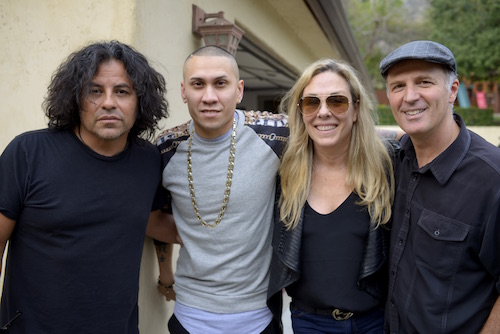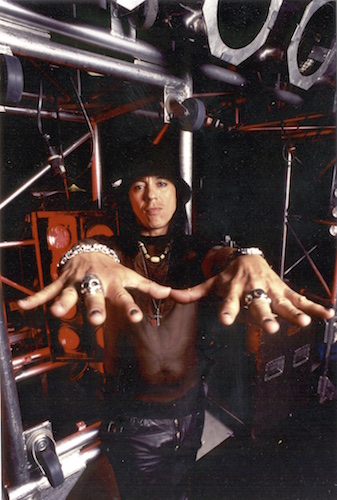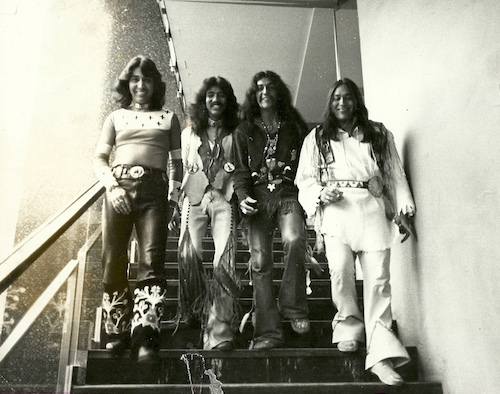Communiqué
RUMBLE: The Indians Who Rocked the World; Monday, December 21 at 10 pm
< < Back to rumble-the-indians-who-rocked-the-world-monday-january-21-at-10RUMBLE: The Indians Who Rocked the World
Airs on Independent Lens
Monday, December 21, 2020 at 10 pm on WOUB
An Electrifying Look at the Native American Influence in Popular Music Despite Attempts to Ban, Censor and Erase Indian Culture
A musical celebration of how Native American musicians transformed blues, jazz and rock, RUMBLE: The Indians Who Rocked the World, will air on Independent Lens Monday, December 21, 2020, 10:00-11:30 PM on WOUB. As the film reveals, early pioneers of the blues such as Charley Patton had Native as well as African American roots, and one of the first and most influential jazz singers, Mildred Bailey, had a voice trained on Native American songs. As the folk rock era took hold in the ‘60s and ‘70s, Native Americans such as Robbie Robertson and Buffy Sainte-Marie helped to define its evolution, and Native guitarists and drummers like Link Wray, Jimi Hendrix, Jesse Ed Davis and Randy Castillo forever changed the trajectory of rock and roll. The film is directed by Catherine Bainbridge (Reel Injun), co-directed by Alfonso Maiorana, executive produced by legendary rock guitarist Stevie Salas (Apache) and Tim Johnson (Mohawk), and produced by Christina Fon, VP and Executive Producer of Rezolution Pictures.

RUMBLE brings the music and musicians to life using innovative re-creations, archival concert footage and interviews. Their stories are told by some of the music legends who knew them, played with them and were inspired by them, including George Clinton, Taj Mahal, Slash, Jackson Browne, Taboo (Shoshone/Mexican), Buddy Guy, Quincy Jones, Derek Trucks, Tony Bennett, Iggy Pop, Steven Tyler and Stevie Van Zandt. Also featured are Native American poet and activist John Trudell, rock critic David Fricke, director Martin Scorsese and many more.
“Anyone who loves contemporary music will hear something they connect with in RUMBLE,” said Lois Vossen, Independent Lens executive producer. “From Link Wray’s iconic guitar riff that made an indelible mark on the evolution of rock, to how Jimi Hendrix’s part-Cherokee heritage shaped his genius, to the spoken music of John Trudell, and Tony Bennett being ‘completely influenced’ by jazz improviser Mildred Bailey, American music is steeped in Native American sounds from Native musicians. History never sounded so good.”
Visit the RUMBLE page on INDEPENDENT LENS, which features more information about the documentary.

About the Major Native American Musicians Featured
Charley Patton (Choctaw/African American, 1887 est.–1934) was a seminal influence on the careers of Robert Johnson, Muddy Waters and Howlin’ Wolf and by extension an influence on rock, most notably the Rolling Stones. He spent his formative years with his family at Dockery Farms in Mississippi, and is a product of the little known mixture of cultures that found stable work and secure living conditions on plantations like Dockery. He raucously played the 1920s delta roadhouses and juke joint scenes and, in an era where the U.S. government banned drums and dance for Native and African Americans, creatively used the guitar as a percussive instrument.
Mildred Bailey (Coeur d’Alene, 1907–1951) has been praised as the first non-African American jazz singer to successfully adapt the rhythms and improvisational flavors of Dixieland and ragtime into swing jazz. Mildred started out with some of the best jazz musicians in New York City, where she was a regular act at the first integrated speakeasies. Her unique style of singing, now a standard for jazz singing, is uncannily similar to the type of singing that Mildred heard on visits to the Coeur d’Alene Indian reservation with her Native American mother.
Link Wray (Shawnee, 1929–2005) originated a raw guitar sound shaped by volume, distortion and simple song structures that became a hallmark of rock and roll. He is almost universally credited with inventing the “power chord” and inspired such major rock figures as the Who’s Pete Townshend, MC5’s Wayne Kramer, Guns N’ Roses’ Slash and other guitar legends. His “Rumble” was an instrumental song that was banned from radio for fear that it would incite teenage violence.
Buffy Sainte-Marie (Cree, b. 1941) was one of the most influential folk singers of the 1960s. She developed her style first in college cafes and later as a member of the Greenwich Village circle that included Peter La Farge and Bob Dylan. Her ballads about Native history carried on La Farge’s tradition, and her social commentary during the Vietnam War era with songs such as “Universal Soldier” earned her attention as a notable voice of conscience.

Jimi Hendrix (Cherokee/African American/Scottish, 1942–1970) is widely considered the most influential guitarist in music history. His Native ancestry was inherited from his paternal grandmother, the first traveling performer in the family, following the vaudeville circuit across the country.
Robbie Robertson (Mohawk, b. 1943) was already an accomplished songwriter and guitarist when Bob Dylan hired him and his friends from the Hawks for the historic tour where Dylan went “electric.” Robbie went on to be one of the founders of the iconic The Band, which became a commercially successful roots-music vehicle, groundbreaking in the world of Americana for its eclectic instrumentation, purity of sound and pop refrains sung in a unique, angelic tonality.
Jesse Ed Davis (Kiowa/Comanche, 1944–1988) grew up in a family of musicians in Oklahoma, where he was conscious of the racial boundaries that made him feel “a little weird being Indian,” especially when it came to pursuing rock and roll. Sought after by the biggest stars in rock because of his unique soulful sound, he was the lead guitarist for Taj Mahal.
Brothers Pat (b. 1939) and Lolly (1939–2010) Vegas (Yaqui/Shoshone) formed Redbone in 1968, after almost a decade in the music industry. During that time, the duo kept trying different gimmicks to stand out in the L.A. music scene, including surf music and Cajun music. It was Jimi Hendrix who told them to just “do the Indian thing, man,” and they launched it as Redbone. Their classic hit “Come and Get Your Love” earned them a permanent place among the most memorable song makers of the ‘70s.

